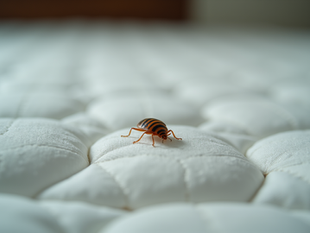
How to Spot the Signs of a Bedbug Infestation at Home: Early guild to bedbug detection
1
169
0
Noticing an itch after waking up? Finding small dark spots on your sheets? These could be signs of a bedbug infestation. These tiny, nocturnal pests can wreak havoc on your home and your health. Knowing how to spot the signs early is essential for successful eradication. In this post, we will guide you through the signs of a bedbug infestation at home, so you can take action before the problem gets worse.
Understanding Bedbug Detection
Bedbugs are elusive creatures that often hide in plain sight. Knowing what to look for is crucial in the early detection of an infestation.
Common Signs of Bedbugs
Bites on Your Body
Bedbug bites typically appear as small, red, itchy welts. They often resemble mosquito bites but can appear in clusters or lines on your skin. Pay close attention to areas that are exposed while sleeping, such as your arms, legs, and neck.
The American Academy of Dermatology reports a rise in bedbug bites, highlighting the need for vigilance.
Dark Spots on Bedding
Check your mattress and sheets for tiny dark spots, which can be a sign of bedbug excrement. These stains can be red, brown, or black and may be mistaken for ink or dirt at first glance. If you see these marks, it’s time to investigate further.

Dark spots indicating potential bedbug presence.
Where to Look for Bedbugs
Knowing where to search is just as important as identifying their signs. Bedbugs have a penchant for hiding in cracks and crevices.
Mattresses and Box Springs
The most common hiding spots for bedbugs are mattresses and box springs.
Inspect the seams and folds of your mattress.
Don’t forget the underside of the box spring.
Furniture and Baseboards
Bedbugs can also be found in upholstered furniture.
Look under cushions, in seams, and along the edges of chairs and sofas.
Examine baseboards and wallpaper, as bedbugs can hide there as well.

Identifying Bedbug Eggs
Finding bedbug eggs is crucial in determining the severity of an infestation.
Egg Characteristics
Bedbug eggs are approximately the size of a pinhead, white or translucent, and often tucked away in small crevices. You may find them in clusters near where adult bedbugs hide.
Reproductive Cycle
A female bedbug can lay up to 500 eggs in her lifetime, making it vital to identify and eradicate them early.
Consider hiring a bed bug inspection service to ensure complete eradication.
Odor as an Indicator
Another noticeable sign of a bedbug infestation is the presence of a sweet, musty odor. This scent comes from the bedbugs' scent glands and can be more pronounced in heavy infestations.
Understanding the scent:
The odor is often described as similar to overripe raspberries or a damp, moldy towel.
If you notice this smell in your bedroom or nearby areas, it could be a warning sign.
Social and Environmental Factors
Bedbug populations thrive in crowded, warm environments. Certain social and environmental factors can increase the likelihood of an infestation.
Increased Travel
Due to the rise in global travel, bedbugs have become a common problem in hotels and public transportation. While vacationing or commuting, inspect your luggage and clothing to avoid bringing these pests home.
Shared Living Spaces
Apartments and multi-unit dwellings are at higher risk for infestations. If your neighbor has reported a bedbug problem, take extra care to inspect your space and take preventive measures.
Statistics show that around 75% of pest control professionals have encountered bedbugs within the last year.
Managing Bedbug Infestations
If you suspect that bedbugs have made themselves at home, taking action quickly can save you time, money, and discomfort.
DIY Inspection Tips
Use a Flashlight
A flashlight can be your best friend while inspecting for bedbugs. Look in dark areas like closets, under the bed, and behind furniture.
Check Electronics
Besides bedding, bedbugs can also hide in electronic devices such as alarm clocks and laptops. Use a vacuum with a hose attachment to catch any pests in hard-to-reach spots.
Professional Help
In some cases, you may require the expertise of a pest control professional. An effective solution may involve heat treatment or chemical pesticides.
Choosing a Pest Control Service
Look for companies that specialize in bedbug detection and removal.
Check reviews and ensure they follow proper protocols for safety.
Prevention Techniques
Preventing bedbugs is easier than dealing with an infestation. Here are some actionable tips to help you keep your home free of these unwelcome guests.
Regular Inspections
Conduct regular inspections of your bedrooms, especially after travel.
Keep an eye out for signs of bedbugs in cluttered areas.
Proper Luggage Care
When returning from a trip, inspect your luggage before bringing it inside. Keep your bags off the floor and use protective luggage covers if possible.
Declutter Your Home
Keeping your home tidy reduces potential hiding spots for bedbugs. Regularly clean and minimize clutter to prevent infestations.
Mattress Protectors
Investing in a high-quality mattress protector can significantly reduce the risk of bedbug infestations. Choose one that is labeled bedbug-proof to ensure effective protection.
Additional Resources for Homeowners
If you’re still uncertain about identifying bedbugs in your home, consider seeking professional guidance. Many pest control companies offer free consultations or resources to help you learn more about these pests.
For thorough assessments, you might also want to reach out for a bed bug inspection service from trained professionals specializing in bedbug detection.
Staying informed and vigilant is the best defense against bedbugs. By learning how to spot the signs early, you can protect your family and home from these unwelcome visitors.
Safeguard your space to ensure a restful night’s sleep and a pest-free home.






